“Our best strategy is to avoid playing the game they want us to play…. Every other way, we lose.”
[Editor’s Note: Today’s guest blog post submission by COL Erik Davis “riffs” its title from the 1959 Hugo Award-winning science fiction novel by Walter M. Miller, Jr. — A Canticle for Leibowitz. This piece is excerpted from COL Davis’ longer magnum opus.
As our regular readers know, storytelling via creative fictional writing and narrative building helps us to envision how new technologies could be employed and operationalized. Our proclaimed Mad Scientists Peter W. Singer and August Cole — co-authors of Ghost Fleet: A Novel of the Next World War and Burn-In: A Novel of the Real Robotic Revolution — coined the phrase fictional intelligence (FICINT) and have explored how storytelling, narrative, verisimilitude, and imagination can help us to better envision future concepts and capabilities.
In today’s post, COL Davis’ FICINT scenario explores a host of key aspects associated with the evolving Operational Environment (OE), including:
-
-
- How China, our pacing threat, could launch and conduct military operations in an effort to seize Taiwan.
- The twin challenges of time and distance faced by the U.S. Joint Force and our Allies and partners when engaging in any conflict with China in their littoral area.
- The divergent ways in which China’s People’s Liberation Army (PLA) and the U.S. Joint Force may harness the power of Artificial Intelligence (AI) to transform the speed at which they fight.
- New sources of vital national talent that could be recruited, and the associated social tensions that may arise within the Force.
- The overarching issue of trust associated with man-machine teaming.
-
Read on to learn how avoiding playing China’s game may be the only way to beat them — Enjoy!]
Finis Lumen* (v1.12.23.1947)
Tomorrow, INDO-PACOM
Colonel Robert Brewster walked into the tactical operations center, scanning the screens and dry-erase boards as he walked. Around him there was a palpable unease as staff officers buzzed about, just a beat shy of panic. One day earlier, the People’s Republic of China had declared an air defense identification zone (ADIZ) that covered everything from the Ryukyus in Japan across to northern Luzon before linking in with the South China Sea and pushing out to the Straits of Malacca and Sunda. Only two hours earlier, the PRC’s AI-enabled air defense net had shot down two flights. The first was an AWACs out of Kadena Air Force Base, struck as it was crossing the Miyaki Strait. The second was a civilian Thai Airlines flight, which apparently suffered some sort of comms issue before entering the newly declared Chinese communist territory.

As people busied themselves about, Brewster could tell the room was on edge. People were pouring themselves into work to avoid thinking about how screwed they were. With the ADIZ up, there was no one coming. At least not until TRANSCOM could get the 82nd onto more C-17s than were currently parked at Pope Army Airfield.
And who cares if they could? Brewster dismissed the idea, remembering the last time “America’s Division” had tried to train in the jungles of the second island chain. They had barely gotten a platoon on the ground and had quit halfway to the objective. It’s just us out here.
Brewster was familiar with the mood in this room. It took him back to his days as a platoon leader in Afghanistan, when 32 pairs of eyes pivoted to him with the unspoken question: What now? So, he did what he always did. Start movement. They just need a little push and then momentum will take it from there.
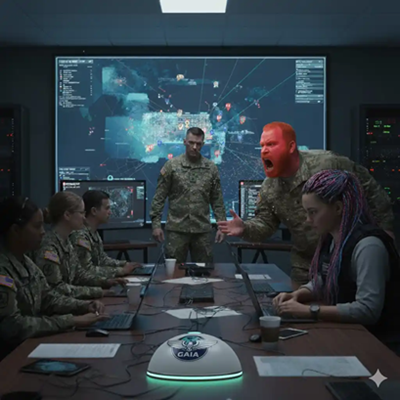 He scanned the room and found the two people he was looking for arguing over a chest-high table with a hastily printed map on it; there hadn’t even been time to laminate it. Lieutenant Colonel Stephen Wheatley’s uniform struggled to contain him on a good day, but it looked fit to burst as he yelled, red in the face, at the noticeably younger female in civilian clothes. Across from him, and just outside spittle range, stood Kora Krizhevsky, a contractor with the fancy duty title of “AI assistant.” She was ignoring Wheatley while a rotating queue of staff officers each took their turn to walk up to her with their tablets. Each in turn took her direction, and then hastily moved out of the impact area of the pair.
He scanned the room and found the two people he was looking for arguing over a chest-high table with a hastily printed map on it; there hadn’t even been time to laminate it. Lieutenant Colonel Stephen Wheatley’s uniform struggled to contain him on a good day, but it looked fit to burst as he yelled, red in the face, at the noticeably younger female in civilian clothes. Across from him, and just outside spittle range, stood Kora Krizhevsky, a contractor with the fancy duty title of “AI assistant.” She was ignoring Wheatley while a rotating queue of staff officers each took their turn to walk up to her with their tablets. Each in turn took her direction, and then hastily moved out of the impact area of the pair.
Brewster sighed. He was not quite forty, younger than Lieutenant Colonel Wheatley, something that clearly chaffed. He’d been promoted quickly in the last five years as far-off 2049 had suddenly become 2039 and then 2029. When the PRC naval drills surrounded Taiwan with a temporary heart-shaped blockade, the tides shifted in the Department of War. Any officer who knew anything about coding was abruptly moved to the front of promotion lists.
Seven years before, on a spur-of-the-moment decision, Brewster self-enrolled in an AI course that SOCOM had arranged with MIT. Someone, somewhere decided that was enough credentials for the fight ahead. It was amazing what the military could do when existential threats focused their mind. Robert was worried people would figure out how little he knew about AI, but quickly discovered none of his older peers were any more qualified.
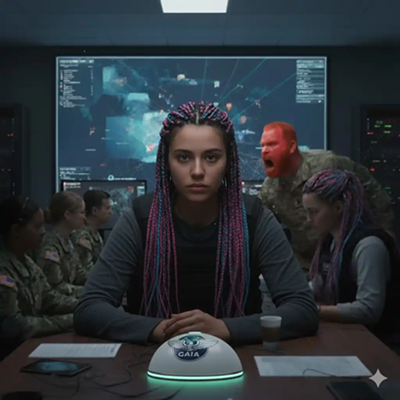 Meanwhile, Kora (or “that civilian” as Wheatley referred to her) was barely more than twenty-five. Her braids alone would have pissed off Wheatley, who was old enough to revere a time when the military didn’t tolerate such things. But their pink and blue dye was what set the field grade on the verge of a coronary. She was also autistic, something she not only freely admitted, but seemed slightly aloof about. Brewster found himself regularly defusing conflicts between the two and was annoyed at this additional role of intermediary between not just two generations, but seemingly two different ways of seeing the world.
Meanwhile, Kora (or “that civilian” as Wheatley referred to her) was barely more than twenty-five. Her braids alone would have pissed off Wheatley, who was old enough to revere a time when the military didn’t tolerate such things. But their pink and blue dye was what set the field grade on the verge of a coronary. She was also autistic, something she not only freely admitted, but seemed slightly aloof about. Brewster found himself regularly defusing conflicts between the two and was annoyed at this additional role of intermediary between not just two generations, but seemingly two different ways of seeing the world.
Kora spotted Brewster and recognizing him as an exit to her intractable situation, pivoted to the Colonel.
“We’ve just uploaded the latest build of GAIA and it’s online and waiting to help,” she opened, notably leaving off the “sir.” She routinely forgot the honorific, though it was clear to Brewster she didn’t imbue one ounce of respect in the syllable when she did remember it.
Brewster looked at the small white metal dome on the table, before realizing the device and its comforting pulsing teal light was more for him than the AI. GAIA, or General Artificial Intelligence Advisor, was integrated into every system before Brewster had even set foot on this island. The dome was just a microphone. There would be a local instance in a server stack somewhere nearby that would speed processing at their location and prevent electronic warfare jamming. At the same time, GAIA would be reaching back to a cloud copy of the base AI where it could spin up more resources as long as communications weren’t disrupted.
 Someone had decided that, like all good military things, GAIA needed a logo, and so there was a sticker on top of the dome. Why a system named after an earth goddess was being represented by an eagle wasn’t clear, but Brewster was just happy whoever had designed the logo hadn’t used the skulls so typical in army paraphernalia. Wrapped in the eagle’s wings was a globe with GAIA stamped across the lower hemisphere in block letters.
Someone had decided that, like all good military things, GAIA needed a logo, and so there was a sticker on top of the dome. Why a system named after an earth goddess was being represented by an eagle wasn’t clear, but Brewster was just happy whoever had designed the logo hadn’t used the skulls so typical in army paraphernalia. Wrapped in the eagle’s wings was a globe with GAIA stamped across the lower hemisphere in block letters.
“Gaia, what is the situation?” Brewster asked.
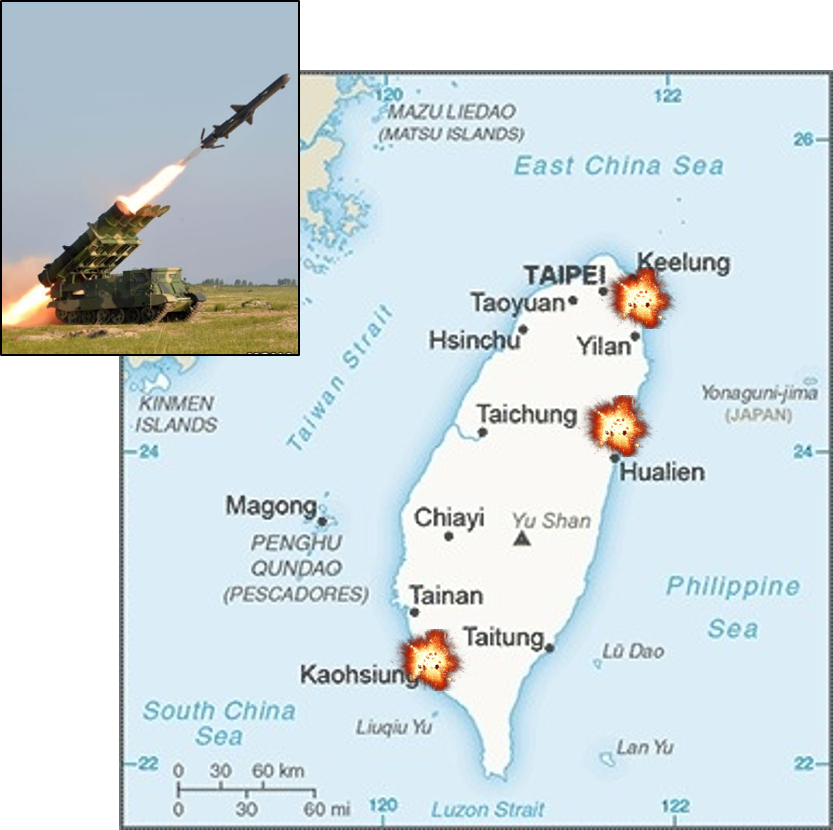 GAIA responded, “The PRC have launched over three dozen strikes onto mainland Taiwan. The fleets we have been observing them amass for a month in Fujian have set sail. The invasion of Taiwan has commenced.”
GAIA responded, “The PRC have launched over three dozen strikes onto mainland Taiwan. The fleets we have been observing them amass for a month in Fujian have set sail. The invasion of Taiwan has commenced.”
Brewster sat heavily upon hearing the news, steepling his hands as he leaned forward.
“Meanwhile,” the device continued, “the combined Joint force has amassed only two brigades of combat power within the first island chain. The third Marines have 67.23% of their units on the island, and the Japanese Diet has already voted to respond in full, though their forces are at least a week away from deployment.”
Still processing the horrendous situation his forces were abruptly facing, Brewster automatically bought time with levity, forgetting what he was speaking to. “Gaia, you sound older. I think I knew your daughter,” he let slip, reminiscing about much simpler days when he’d used a GAIL as a company commander in Afghanistan.
The AI paused for a barely perceptible moment before responding, “The GAIL you knew was of a much older generation; as distant from me as Cleopatra is to you.”
Colonel Brewster couldn’t hide the smirk that came unbidden to his face. When he glanced around, he clocked a grinning Kora and sighed. Was it any surprise that the AIs and auties got on so well?
“So, if you’ll pardon the language, what the hell do we do?” Brewster asked, sagging as he braced himself on the table. The weight on his shoulders was palpable, and the hastily built table was the anchor his world needed at that moment.
 Before Kora or GAIA could respond, Wheatley roared in, trying to project as much of himself and his voice into the debate. “We need to reinforce Kinman and Matsu. That’s where their fleets are headed, and we must prevent them from taking the islands.”
Before Kora or GAIA could respond, Wheatley roared in, trying to project as much of himself and his voice into the debate. “We need to reinforce Kinman and Matsu. That’s where their fleets are headed, and we must prevent them from taking the islands.”
Brewster spotted Kora’s back stiffening as she readied a retort. He cut her off, boxing her out as he turned in his chair to face Wheatly. “What would that take?”
Wheatly paused momentarily. He was not anticipating Kora being interrupted, and his counter to her counterargument was halfway out his mouth before he realized what he’d been asked. He quickly adjusted, “Both brigades, sir. Immediately deployed to the forward islands to bolster Taiwan’s defenses.”
“With what lift?” Kora challenged. Brewster interjected by raising his hand, before Wheatly could unleash another rejoinder.
“Why the islands? They’re just rocks, and closer for the PRC to attack than for us to defend,” he asked Wheatly as he tried to ignore Kora beaming behind him.
“It’s a position move, sir. From both, we can obliterate the PRCs fleets,” Wheatly responded.
“It’s a stupid move,” Kora barked. Again, no sir.
Wheatly went apoplectic, spittle flying from his mouth as he roared, “It’s a smart position. Do you even know how to play wei-chi?”
Kora paused, looking genuinely perplexed. “No, why would I?” she responded.
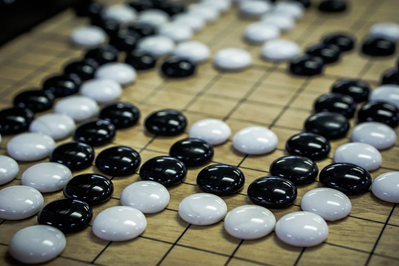 Somehow Wheatly found an even higher level of anger, his face turning from red to purple. “You don’t know wei-chi?” he sniggered, reminding Brewster just why he didn’t like Wheatly. “The game of choice for the PRC? The thousand-year-old contest they’ve been playing this whole time? And you don’t even know how to play it?”
Somehow Wheatly found an even higher level of anger, his face turning from red to purple. “You don’t know wei-chi?” he sniggered, reminding Brewster just why he didn’t like Wheatly. “The game of choice for the PRC? The thousand-year-old contest they’ve been playing this whole time? And you don’t even know how to play it?”
Kora responded in the same flat tone she always did, one that was often taken for arrogance but was better described as indifference. “Why would I waste my time learning Go? A computer bested a human at wei-chi when I was nine.”
Seeing the same tired debate between the two bubbling, Brewster tried a new tack. “Gaia, what is a ‘bad idea’ for this situation?”
Without hesitation GAIA calculated, “Placing a brigade at Kinmen and Matsu to hold the islands. They are doomed to fall, and this would doom all of Taiwan.”
Wheatly stammered, alternating between embarrassed and angry.
Brewster sighed a long sigh, slowly exhaling every bit of air in his lungs before he took a sharp inhale. He pivoted to a grinning Kora, and abruptly his features became very dark. “Ok, bagging on bad ideas is easy. Kora, what does Gaia think we should do?” The teal light on the dome shifted briefly and every screen in the room began to display the same map.
“It suggests we reinforce these three beaches and accept that the external islands are lost,” the woman said. “If the PRC is bluffing, they may take both as a draw bet; but as we just heard, this is an attempt to pin our forces in an untenable position. The islands are threats to the PRC invasion force but have no strategic value to the Taiwanese forces beyond that.” The poker analogy helped Colonel Brewster a lot, but he was still apprehensive.

“What are our projected losses?” he asked, knowing full well the room had heard him.
Kora flinched at the question, one of the only times Brewster had ever seen her show discomfort. “High, sir.” He noted the sir, for once without an acrid tinge of rust in the tone. “Over sixty percent.”
Had he not been sitting at the table already, he would have staggered. Sixty!? More? “How…?” he stammered, “How can Gaia be certain?”
He watched as Kora fought her instinctive eyeroll. “It can’t. It’s just probabilistic.” When that was clearly not enough for the colonel, Kora continued. “It’s a black box. We don’t know how GAIA reaches conclusions.  What we do know is the PRC AI is not trained for ‘centaur’ human-machine teaming. They are straight algo. And as Wheatley pointed out, their AI is probably favoring a wei-chi strategy.”
What we do know is the PRC AI is not trained for ‘centaur’ human-machine teaming. They are straight algo. And as Wheatley pointed out, their AI is probably favoring a wei-chi strategy.”
Sixty percent! Even Kora could read the scale of it on Brewster’s face, who was remembering what just ten percent had done to his command in Afghanistan.
“Our best strategy is to avoid playing the game they want us to play,” Kora offered the struggling colonel. “Every other way, we lose.”
Colonel Brewster stared at her for a long pause, fully aware that every second mattered. “But how does she know?”
“It doesn’t.”
Her flat reply, her flat affect; both unnerved him. Pivoting for a firmer grip, he asked, “What else? What’s already moving?”
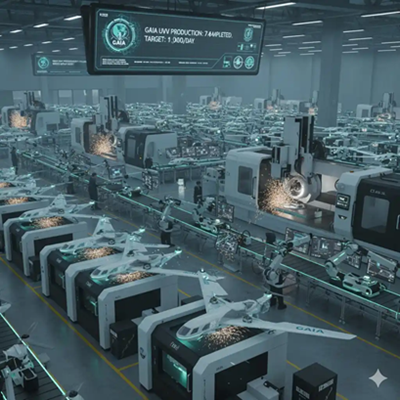 “We’ve already engaged multiple venues, including Amazon’s TacTurk. GAIA is drafting thousands of designs for drones, based off estimated available resources already on island. GAIA has mapped every known CMC machine across Taiwan, along with any PCB and additive printer it can find. Human Turks are flagging bad designs and GAIA is iterating on the available devices here while also working through GitHub programmers to generate code to integrate all the systems.
“We’ve already engaged multiple venues, including Amazon’s TacTurk. GAIA is drafting thousands of designs for drones, based off estimated available resources already on island. GAIA has mapped every known CMC machine across Taiwan, along with any PCB and additive printer it can find. Human Turks are flagging bad designs and GAIA is iterating on the available devices here while also working through GitHub programmers to generate code to integrate all the systems.
“The loggys in the four shop are working with GAIA to iterate through travelling salesman algos to both collect and disseminate all the things. The sigo is building the best pace plan they can with every comms device GAIA can connect up. We’ve also carved out limited access to GAIA instances to the Taiwanese military and public. It’s a lot of innovating on the fly though. No one ever tried whole-of-society human-machine teaming before.”
Kora stared at Brewster, who was actually a bit surprised at how much was already moving. He nodded for her to continue.
“But we have to let the PRC fleet launch. It’s never more vulnerable than it is just off the coast of Taiwan, so we have to let it get in close before we unleash the swarm.”
Brewster couldn’t help but notice even Wheatley was listening to her now.
“ The brigades should be focused on clean-up and preventing the PRC from securing a beachhead. The lion’s work will be done by thousands of Taiwanese fighters and tens of thousands more disposable drones. But even then, the casualties will be high. Higher than humans traditionally tolerate, but well within typical AI tolerances.”
The brigades should be focused on clean-up and preventing the PRC from securing a beachhead. The lion’s work will be done by thousands of Taiwanese fighters and tens of thousands more disposable drones. But even then, the casualties will be high. Higher than humans traditionally tolerate, but well within typical AI tolerances.”
Brewster blanched at Kora as she added the last sentence so casually. No golden hour, no persistent air support, no backtracking. Servicemen would die. A lot of them. The majority of them. Brewster took one more long breath in and out, trying to regain his footing. The decision had to be made. One he knew his senior commanders, bred on twenty years of air superiority and uncontested spectrum, simply would not make.
“How does she know?” he pressed one last time.
Kora stared directly into his eyes and responded without any of the emotion. “It doesn’t. You just have to trust it.” Her lack of emotion overwhelmed him.
Colonel Brewster took another long slow breath, watching the teal light on GAIA’s dome brighten and dim. Inhale over four beats. Hold for one. Out for four. Hold for one. He repeated the cycle twice more. He’d already made the decision, he just needed time to get right with it. “God help me,” he said, “Execute”.
“Gaia help us,” he heard one of the nearby staff officers mumble.
 The sharks that lurked in the Black Ditch** ate well that year, accustomed to the sportive brutality of the sea.
The sharks that lurked in the Black Ditch** ate well that year, accustomed to the sportive brutality of the sea.
* In Walter M. Miller, Jr.’s A Canticle for Leibowitz, “Finis Lumen” serves as a dark premonition or foreshadowing, suggesting that this new “light” (knowledge/technology — i.e., AI) will eventually lead to its own destruction, a “limit” beyond which humanity cannot or will not go without repeating the cycle of self-annihilation. The phrase underscores the novel’s central theme: humanity’s tragic tendency to acquire immense knowledge and power (“light”) without developing the moral wisdom to use it responsibly, thus repeatedly bringing about its own downfall and a return to darkness. The cyclical nature of human civilization is a key message of the novel.
** A calque of Hokkien 烏水溝 / 乌水沟 (O͘-chúi-kau, literally “black ditch”). Proper noun. Black Ditch. Synonym of Taiwan Strait.
If you enjoyed this post, check out the T2COM G-2‘s Operational Environment Enterprise web page, brimming with authoritative information on the Operational Environment and how our adversaries fight, including:
Our T2COM OE Threat Assessment 1.0, The Operational Environment 2024-2034: Large-Scale Combat Operations
Our China Landing Zone, full of information regarding our pacing challenge, including ATP 7-100.3, Chinese Tactics, T2COM OE Threat Assessment 1-1, How China Fights in Large-Scale Combat Operations, 10 Things You Didn’t Know About the PLA, and BiteSize China weekly topics.
Our Russia Landing Zone, including T2COM OE Threat Assessment 1-2, How Russia Fights in Large-Scale Combat Operations and the BiteSize Russia weekly topics. If you have a CAC, you’ll be especially interested in reviewing our weekly RUS-UKR Conflict Running Estimates and associated Narratives, capturing what we learned about the contemporary Russian way of war in Ukraine over the past two years and the ramifications for U.S. Army modernization across DOTMLPF-P.
Our Iran Landing Zone, including the Iran Quick Reference Guide and the Iran Passive Defense Manual (both require a CAC to access).
Our North Korea Landing Zone, including Resources for Studying North Korea, Instruments of Chinese Military Influence in North Korea, and Instruments of Russian Military Influence in North Korea.
Our Irregular Threats Landing Zone, including TC 7-100.3, Irregular Opposing Forces, and ATP 3-37.2, Antiterrorism (requires a CAC to access).
Our Running Estimates SharePoint site (also requires a CAC to access) — documenting what we’re learning about the evolving OE. Contains our monthly OE Running Estimates, associated Narratives, and the quarterly OE Assessment Intelligence Posts.
Then review the following related Mad Scientist Laboratory content…
… on possible PRC invasion scenarios of Taiwan:
Fait Accompli: China’s Non-War Military Operations (NWMO) and Taiwan, by SGT Michael A. Cappelli II
Operation Northeast Monsoon: The Reunification of Taiwan, by Sherman Barto
Flash-Mob Warfare: Whispers in the Digital Sandstorm (Parts 1 and 2), by Dr. Robert E. Smith
Three Dates, Three Windows, and All of DOTMLPF-P and “No Option is Excluded” — Using Wargaming to Envision a Chinese Assault on Taiwan, by Ian Sullivan
Tyranny of Time & Distance: Logistics & Contested Deployment in LSCO and Contested Deployment: A Vignette, by Dr. Stewart Bentley
… on integrating AI into Warfighting:
China’s Emerging Technologies Highly Likely to Undermine U.S. & Allied Advantage by 2035, by proclaimed Mad Scientist COL Byron N. Cadiz
“Intelligentization” and a Chinese Vision of Future War
China’s PLA Modernization through the DOTMLPF-P Lens, by Dr. Jacob Barton
Hybrid Intelligence: Sustaining Adversary Overmatch and associated podcast, with proclaimed Mad Scientist Dr. Billy Barry and LTC Blair Wilcox
Artificial Intelligence (AI) Trends
Takeaways Learned about the Future of the AI Battlefield
Artificial Intelligence: An Emerging Game-changer
Training Transformed: AI and the Future Soldier, by proclaimed Mad Scientist SGM Kyle J. Kramer
Rise of Artificial Intelligence: Implications to the Fielded Force, by John W. Mabes III
Integrating Artificial Intelligence into Military Operations, by Dr. James Mancillas
“Own the Night” and the associated Modern War Institute podcast, with proclaimed Mad Scientist Bob Work
Bringing AI to the Joint Force and associated podcast, with Jacqueline Tame, Alka Patel, and Dr. Jane Pinelis
… on trust and man-machine teaming:
AI Enhancing EI in War, by MAJ Vincent Dueñas
The Human Targeting Solution: An AI Story, by CW3 Jesse R. Crifasi
An Appropriate Level of Trust…
About the Author: COL Erik Davis has over sixteen years of experience in Army special operations. He is a Gen. Wayne A. Downing Scholar whose assignments have taken him from village stability operations in rural villages in Afghanistan to preparing for high-end conflict in the First Island Chain. He is currently an Army War College Fellow with the Australian Strategic Policies Institute, and he writes about data and the army at https://downrangedata.substack.com/.
Disclaimer: The views expressed in this blog post do not necessarily reflect those of the U.S. Department of Defense, Department of the Army, or the Transformation and Training Command (T2COM).



